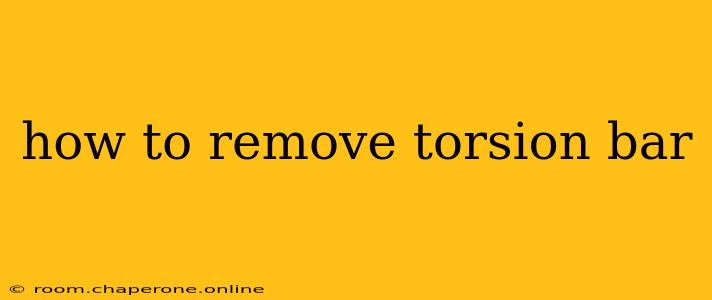Removing a torsion bar can seem daunting, but with the right tools and a methodical approach, it's a manageable task. This guide provides a step-by-step process, crucial safety precautions, and important considerations depending on your vehicle's make and model. Always consult your vehicle's repair manual for specific instructions and torque specifications. This information is for general guidance only and should not replace professional advice.
Understanding Torsion Bars
Torsion bars are a type of spring used in some vehicles' suspension systems. They're essentially long, steel bars that twist to absorb shocks and bumps. Removing them often involves adjustments to the suspension, requiring specialized tools and a good understanding of automotive mechanics.
Tools and Equipment You'll Need
Before you begin, gather these essential tools:
- Vehicle repair manual: Absolutely crucial for specific instructions and torque specifications for your vehicle.
- Jack and jack stands: Safely raise and support your vehicle. Never work under a vehicle supported only by a jack.
- Wheel chocks: Prevent accidental movement.
- Socket set and wrenches: Various sizes will be necessary, depending on your vehicle.
- Torsion bar removal tool: This specialized tool simplifies the process considerably. Improvising can damage components.
- Torque wrench: Essential for tightening bolts to the correct specifications.
- Safety glasses and gloves: Protect yourself from injury.
- Penetrating oil (PB Blaster or similar): Helps loosen rusted or seized bolts.
- Measuring tape or ruler: For accurate measurements and adjustments.
Step-by-Step Guide to Torsion Bar Removal
Disclaimer: The following steps are general guidelines. Your specific procedure may vary significantly depending on your vehicle's make, model, and year. Always prioritize safety and consult your repair manual.
-
Preparation: Park your vehicle on a level surface, engage the parking brake, and chock the wheels. Consult your repair manual to locate the torsion bar(s) and any related components.
-
Vehicle Elevation: Safely raise the vehicle using your jack and secure it with jack stands. Ensure the vehicle is stable and secure before proceeding.
-
Component Access: Remove any components that obstruct access to the torsion bar, such as wheels, brake calipers (if necessary), or other suspension parts, according to your repair manual.
-
Disconnecting the Torsion Bar: This is where the torsion bar removal tool becomes indispensable. The specific method will depend on your vehicle's design. Generally, you'll need to loosen or remove attaching bolts and then use the tool to carefully unwind and remove the torsion bar. Proceed slowly and carefully to avoid damage.
-
Measurement and Recording: Before completely removing the torsion bar, carefully measure its position and make a detailed note of its adjustment. This is crucial for reinstallation and maintaining proper suspension geometry.
-
Removal: Once the torsion bar is loosened, carefully remove it from its mounting points.
-
Reassembly (Reverse Order): Follow the steps in reverse order for reassembly, ensuring all components are correctly aligned and tightened to the manufacturer's specifications using a torque wrench.
-
Lowering the Vehicle: Once reassembled, carefully lower the vehicle from the jack stands.
-
Final Check: After lowering, inspect your work and double-check all connections. Test-drive the vehicle carefully to ensure the suspension is functioning correctly.
Important Safety Precautions
- Never work under a vehicle supported only by a jack. Always use jack stands.
- Wear safety glasses and gloves.
- Use caution when handling sharp tools and components.
- Consult your vehicle's repair manual throughout the entire process.
- If you're unsure about any step, seek professional assistance from a qualified mechanic.
When to Seek Professional Help
If you lack experience with automotive repair or are uncomfortable performing this task, it's best to consult a qualified mechanic. Improper removal or reinstallation of a torsion bar can lead to serious damage to your vehicle's suspension and handling. Don't hesitate to seek professional help if needed; it's a worthwhile investment in the safety and longevity of your vehicle.

